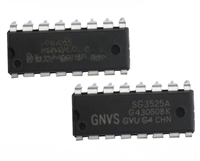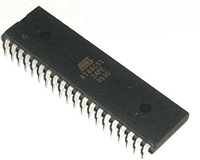The S-module contains a full implementation of the C-module
plus a clearable sequential element that can either
implement a latch or flip-flop function. The S-module can
therefore implement any function implemented by the
C-module. This allows complex combinatorial-sequential
functions to be implemented with no delay penalty. The
Designer Series Development System will automatically
combine any C-module macro driving an S-module macro into
the S-module, thereby freeing up a logic module and
eliminating a module delay.
D00
D01
D10
OUT
Y
D11
S1
S0
The clear input CLR is accessible from the routing channel.
In addition, the clock input may be connected to one of three
clock networks: CLKA, CLKB, or HCLK. The C-module and
S-module functional descriptions are shown in Figures 2
and 3. The clock selection is determined by a multiplexor
select at the clock input to the S-module.
A1 B1
A0 B0
I/O s
Figure 2 • C-Module Diagram
I/O Modules
preset/clear network (IOPCL). Either preset or clear can be
selected individually on an I/O module by I/O module basis.
I/O modules provide an interface between the array and the
I/O Pad Drivers. I/O modules are located in the array and
access the routing channels in a similar fashion to logic
modules. The I/O module schematic is shown in Figure 4. The
signals DataIn and DataOut connect to the I/O pad driver.
Each I/O module contains two D-type flip-flops. Each flip-flop
is connected to the dedicated I/O clock (IOCLK). Each
flip-flop can be bypassed by nonsequential I/Os. In addition,
each flip-flop contains a data enable input that can be
accessed from the routing channels (ODE and IDE). The
asynchronous preset/clear input is driven by the dedicated
The I/O module output Y is used to bring Pad signals into the
array or to feed the output register back into the array. This
allows the output register to be used in high-speed state
machine applications. Side I/O modules have a dedicated
output segment for Y extending into the routing channels
above and below (similar to logic modules). Top/Bottom I/O
modules have no dedicated output segment. Signals coming
into the chip from the top or bottom are routed using F-fuses
and LVTs (F-fuses and LVTs are explained in detail in the
routing section).
D00
D01
Y
D
Q
OUT
D10
D11
S1
S0
CLK
CLR
A1 B1
A0 B0
Figure 3 • S-Module Diagram
1 -1 8 2






 SG3525资料手册详解:SG3525参数分析、引脚说明、应用介绍
SG3525资料手册详解:SG3525参数分析、引脚说明、应用介绍

 AT89C51单片机资料手册详细解析及应用示例
AT89C51单片机资料手册详细解析及应用示例

 CP2102资料手册解读:CP2102引脚说明、关键参数分析
CP2102资料手册解读:CP2102引脚说明、关键参数分析

 资料手册解读:UC3842参数和管脚说明
资料手册解读:UC3842参数和管脚说明
